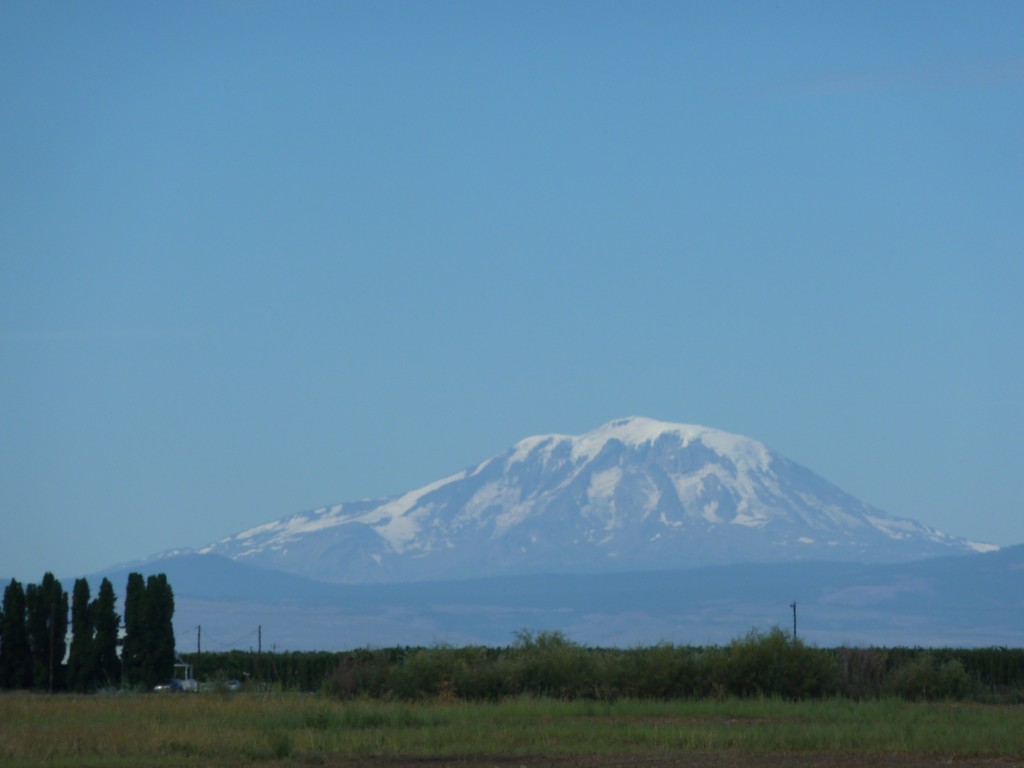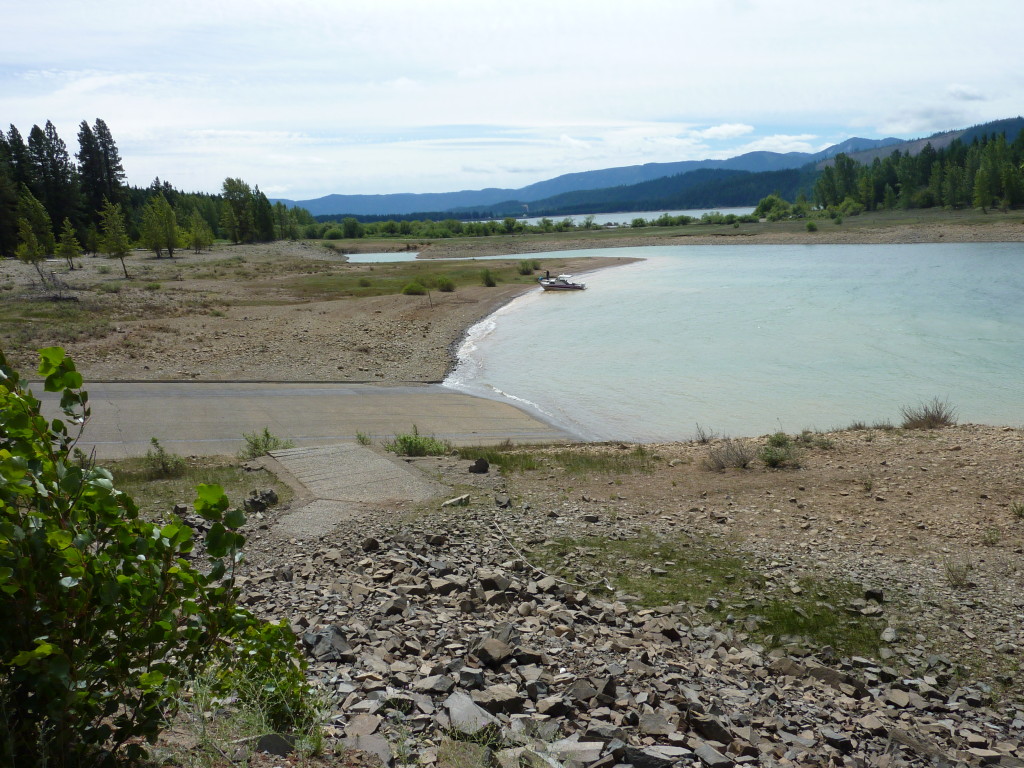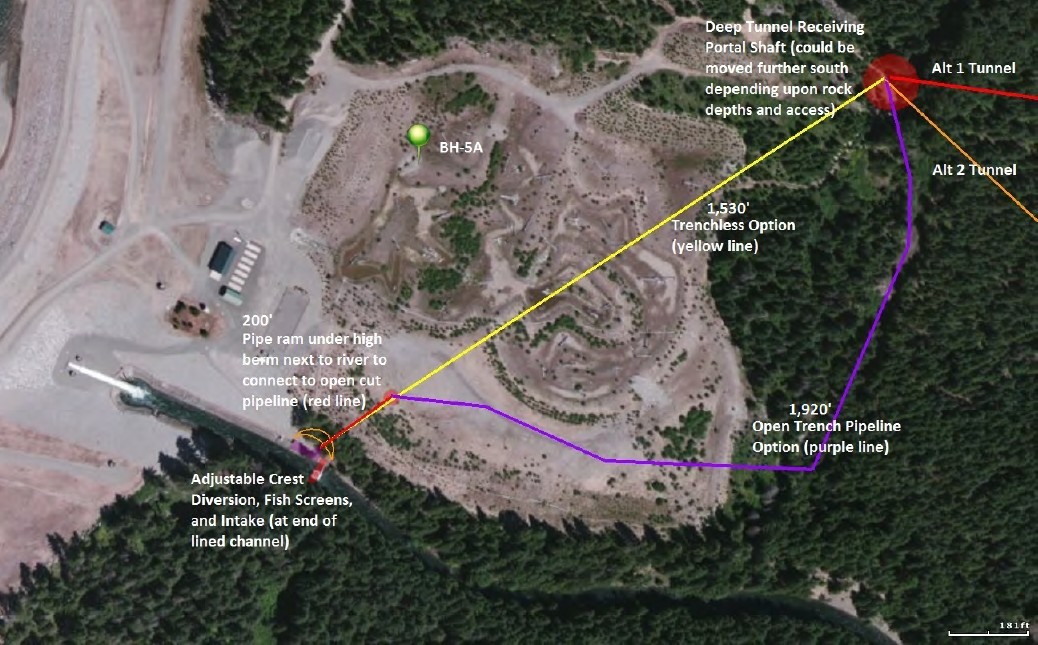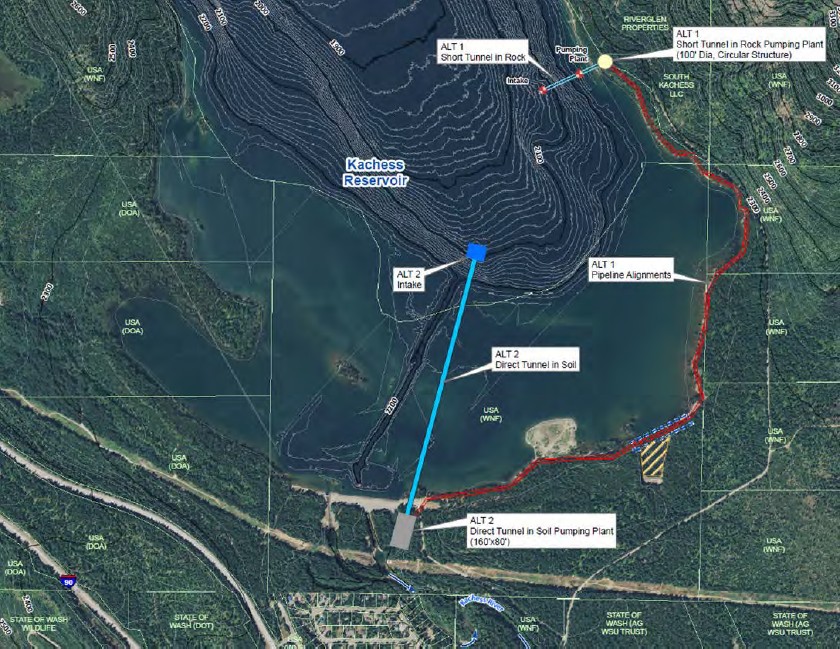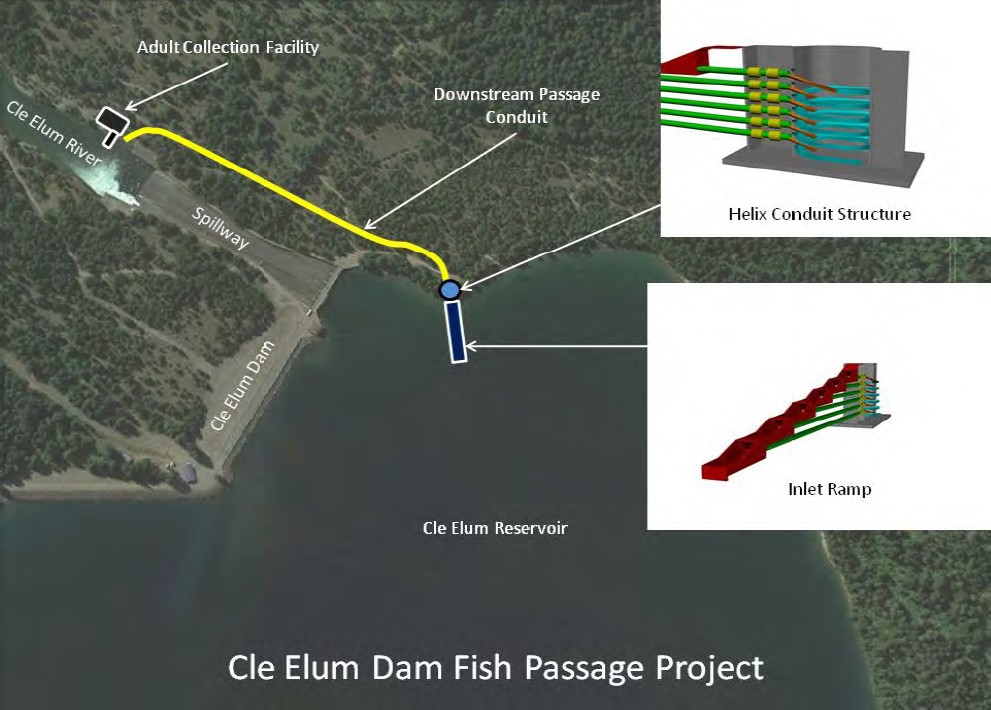YBSA Monthly Report February, 2015
YBSA Monthly Report
February, 2015
Possible Drought Conditions: Once again the Yakima Valley agricultural community is in danger of drought conditions due to the lack of snowfall in the Cascade Mountains. The water needed for instream flow (fish) and out of stream needs (irrigation) may not be available. Our five reservoirs in the Yakima Basin are more than 90% full, but that amount of water only provides about 1/3 of what is necessary. The runoff from the average snowpack in the mountains provides the additional 2/3 of the water necessary to provide what is needed annually in the Yakima Basin. As of the end of February, the U.S. Bureau of Reclamation’s Yakima Project Systems Status NRCS Snotel sites for the upper Yakima Basin has 22% of normal snow pack and the lower basin sites are reporting 38% of the average snow pack. Without a large snowfall in the next 2 months the Yakima Basin could be in for drought conditions this summer.
YBSA Response to DEIS: YBSA is submitting a response to the Draft Environmental Impact Statement (DEIS) for the proposed Kachess Drought Relief Pumping Plant (KDRPP) and Keechelus Reservoir-to-Kachess Reservoir Conveyance (KKC) projects. YBSA’s mission is to ensure an adequate supply of water for now and future generations for all water interests in the Yakima Basin. While we support the Integrated Plan in the goal to propose and implement projects that enhance aquatic ecosystems, improve drought-year supplies for agriculture, and provide for future municipal needs, we have concerns about the proposed projects.
The December 2014 WorkGroup meeting notes report that the Implementation Committee is currently working on an authorization bill for the KKC,KDRPP, Cle Elum Pool Raise Project, fish passage, and water conservation initiatives. The exclusion at this time of the other two major storage projects as reasonably foreseeable future actions, the approach being taken for storage authorization and appropriations, the significant unavoidable adverse impacts indicated in the DEIS, and stakeholders adamantly opposing this action and a somewhat similar action with respect to the existing Bumping Lake are not very reassuring that joint water storage operations presented to date in the Integrated Plan will be a reality. It is most apparent however, that the KDRPP and KCC projects will not meet drought year water needs and will very adversely impact the immediate area. Under these circumstances is this a wise investment? The full response is available at www.ybsa.org.
Friends of Lake Kachess Editorial in the Northern Kittitas County Tribune: I am writing as a resident of North Kittitas County to express my grave concern and opposition to the controversial Yakima River Basin Water Enhancement Project (YRBWEP). This proposal would transfer water from Lake Keechelus and Lake Kachess to junior water rights holders in the Yakima Basin at a cost approaching $1 billion. It would drain 200,000 acre feet of water a year from the two lakes and spill it into the Yakima River, to be taken out by irrigators. To be clear, an acre foot of water is one acre, one foot deep in water. Now imagine one acre of water…38 miles high! Or think of it as an acre of water the height of 14 Mt. Rainiers! That is the additional amount of water that would be drained from our two lakes in Kittitas County.
The devastating impacts of such an act on our environment is hard to imagine. However the Draft Environmental Impact Statement (DEIS) just released on this project acknowledges it will deplete the aquifer, endanger threatened fish species, reduce recreational opportunities for individuals and families, possibly cause wells to fail, and permanently destroy elements of a fragile ecosystem enjoyed by thousands of Washingtonians. Despite the clear risks represented by the project, the DEIS only states that it will “monitor and mitigate” damages after they occur. This is unacceptable and should be opposed by everyone who cares about protecting our environment for future generations.
But the damage to our environment is not even the worst of this controversial project. A study conducted by distinguished scientists from Washington State University and the University of Washington, at the request of the Washington State Legislature, documented it is not only an environmental disaster, it is an economic disaster. A team of scientists and economists conducted a Benefit-to-Cost analysis of the two projects that are now being considered by the Legislature. They showed conclusively that costs would far exceed benefits. In fact one project would lose $.80 of every taxpayer dollar spent, and the second project would lose $.54 of every taxpayer’s dollar. No private enterprise would consider such a venture, and no public initiative should either. At a time when our State is facing serious challenges with regard to funding critical needs in education and infrastructure, it is unacceptable to waste taxpayer money in such a manner.
In summary, YRBWEP represents an effort by special interests in Yakima Basin to drain water from our aquifer, and even worse to drain dollars from Washington taxpayers for this environmental and economic disaster. In the strongest terms possible, I urge Tribune readers to oppose YRBWEP; neither we nor our environment can afford it.
Included with the permission of
Bill Campbell, PhD
Friends of Lake Kachess
Easton, WA
YBSA Monthly Report January, 2015
YBSA Monthly Report
January, 2015
Kachess Drought Relief and Keechelus to Kachess Conveyance: One of the proposed storage sites in the Yakima Basin listed in the Integrated Plan is to pump an additional 200,000 a/f of water from Lake Kachess below the normal annual drawdown. The Integrated Plan was developed to provide more water for fish, agriculture, and municipal use in the Yakima Basin.
The Draft Environmental Impact Statement (DEIS) for the proposed action of implementing the Kachess Reservoir Drought Relief Pumping Plant (KDRPP) and the Keechelus to Kachess Conveyance (KCC) alone or in combination is available. A Bull Trout Enhancement (BTE) package in the tributaries above the two reservoirs as well as throughout the Yakima Basin has been added. The proposed project creates a major change in the environment in the Kachess and Keechelus Basins adversely impacting slack water recreation, lake fishing, and shoreline camping.
Public comments can be submitted to the Bureau of Reclamation by March 1, 2015. The DEIS is very voluminous and difficult to track concerns and issues that makes it difficult to identify the severity of the potential impacts on the current resources. For example, the DEIS compares the No Action and Action Alternatives with continuation of the historical hydrologic conditions in detail, but is lacking when it comes to similar detailed information on reservoir draw down, refill durations, impacts on reservoir fishery, bull trout tributaries, and general visual quality of the area for the moderately adverse and more adverse climate change scenarios.
Benefit-Cost-Analysis of the Yakima River Basin Integrated Plan Project: The report was completed by the State of Washington Water Research Center, Washington State University. The following are conclusions presented to the Integrated Plan Work Group at the December 17th meeting:
- Individual storage and conservation does not pass the benefit-to-cost (B/C) test as part of a full Integrated Plan implementation.
- Cle Elum raise approaches B/C viability alone in the most adverse drought scenario only; KKC-KDRPP also, less so (and with more caveats).
- Market gains from trade are predictability substantial with active market development.
- Fish passage projects are the most likely to satisfy and B/C test.See the Bureau of Reclamation website at http://www.usbr.gov/pn/programs/yrbwep/2011integratedplan/index.html for the complete DEIS.The language in the DEIS does not address the issue of is there enough water annually to provide an adequate and reliable water supply for the Yakima Basin.A link to the complete DEIS is posted on the www.ybsa.org website.Visit our website at www.ybsa.org
See the Bureau of Reclamation website at http://www.usbr.gov/pn/programs/yrbwep/2011integratedplan/index.html for the complete DEIS.
The language in the DEIS does not address the issue of is there enough water annually to provide an adequate and reliable water supply for the Yakima Basin.
A link to the complete DEIS is posted on the www.ybsa.org website.
YBSA Monthly Report December, 2014
YBSA Monthly Report
December, 2014
Benefit-Costs of the seven elements of the Integrated Plan: The Washington State Legislature authorized in the Capital Budget for 2013, the preparation of a separate benefit-cost analysis for each of the projects proposed in the Integrated Plan.
The WSU Washington State Water Research Center presented their report on the benefit-cost of individual projects in the Integrated Plan to the Yakima River Basin Water Enhancement Project Work Group.
The economic study pointed out the following:
1. The major storage projects of the Integrated Plan, when implemented together, are unlikely to provide positive net benefits.
2. Net benefits for individual water storage projects are negative, with some exceptions under the most adverse climate and water market conditions
3. Instream flow benefits for fish are insufficient to support water storage infrastructure given the net benefit shortfall in out-of-stream use benefits, but proposed instream flows may be supportable through market purchases.
4. Insufficient evidence exists to assess the economic efficacy of fish habitat restoration with a useful degree of precision.
5. Reservoir fish passage projects are likely to provide positive net benefits through their pivotal role in supporting wild Sockeye reintroduction into the basin.
6. Water markets show potential for reducing the impacts of basin wide curtailment.
The draft report can be found at www.swwrc.wsu.edu
Integrated Plan Work Group Implementation Committee Comments:
1. The Implementation Committee does not believe that a “disaggregated” evaluation of the Integrated Plan can provide a realistic assessment of the Integrated Plan’s full value. It would seem, however, to have been appropriate to provide more than just a passing recognition of the results of the aggregated benefit/cost analysis conducted by the Bureau of Reclamation in 2012, which did attempt to account for synergies among the Integrated Plan’s projects and activities. In addition, the title of the report should also be modified to clearly reflect that it is, by design, a disaggregated analysis and, as such, views the Integrated Plan in a way that is contrary to the manner in which it is actually structured and has been proposed.
2. It is important to note that the economic analysis that was conducted by the Bureau of Reclamation in 2012 did, in fact, include use of a disaggregated analysis of plan components as a starting point for conducting the aggregated analysis, Reclamation’s analysis also concluded that, when viewed in isolation, a number of the Integrated Plan projects, particularly the surface water storage projects, do not yield positive benefit/cost ratios. The Implementation Committee of the Integrated Plan Work Group does not labor under the illusion that an isolated project that is designed primarily to provide water on a
sporadic basis in response to water shortages and droughts can yield a positive benefit/cost ratio using traditional methods of evaluation.
3. We firmly believe that the Integrated Plan provides the Yakima River Basin with the tools needed to preserve the basin’s economy, to restore the basin’s once prolific salmon and steelhead runs, and to provide resiliency in the face of climate change impacts that are predicted to have devastating effects on the basin’s snowpack and mid-to-late summer stream flows.
Additional information can be found at www.usbr.gov/pn/programs/yrbwep/2011integratedplan/index.html when posted.
YBSA’s Comments on the Draft WSU Economic Impact Report of the Integrated Plan:
1. The Bureau of Reclamation’s water resources planning process involves a “plan formulation step” in which the costs of potential measures/actions are tested against their economic monetary benefits. Essentially what this involves is building the Integrated Plan from an economically justified core to a final proposal of justified increments, and those increments, which because of other non-monetary attributes, should be included. In the case of the Integrated Plan, which is now before us, plan formulation did not occur in this manner. Rather, the concept was the synergistic nature of the Integrated Plan as a whole, which in this case, bypassed the plan formulation step. An equitable distribution of the total benefits at this time is difficult and can have significant impacts on how the Integrated Plan is perceived. It is not surprising that the disaggregation of the total benefit categories results in some individual projects not having positive net benefits and a benefit to cost ration of 1 or greater.
2. Irrigation benefits are computed as the net farm revenue generated from agricultural production resulting from the proposed action; in this case providing a supplemental water supply in dry years. Net revenues reflect the crops grown, the values of those crops, and the costs incurred by the farmer in producing the crops. These are “direct benefits” and do not include “indirect benefits” which are generated as a by-product of farm production in the regional economic area and throughout the State of Washington.
Complete comments can be found at www.ybsa.org
Visit our website at www.ybsa.org
YBSA Monthly Report November, 2014
YBSA Monthly Report
November, 2014
Testimony at Honeyford’s Meeting on a Water Bill: YBSA presented the following testimony at Senator Jim Honeyford’s Public Meeting on water bill being proposed to fund projects that address needed Storage.
YBSA is a volunteer organization with multi-generational experience in water and environmental issues in the Yakima Basin. Our mission is to ensure there is an adequate water supply in the Yakima Basin for all users: municipal, agriculture, Tribal, environmental, and recreation, for generations to come.
In the Yakima Basin, our entire economy is based on a thriving agriculture sector. Without an adequate storage of water to weather drought years and potential changes in hydrologic patterns due to climate change, our Basin is left vulnerable. Other irrigated basins typically have storage for 2-3 years of water supply; our basin has less than 1 year of water storage. This means that every year our supplies are in jeopardy until as late as May. And when severe droughts hit our area, our economy suffers greatly, not just during the drought years, but for many years after.
We support the proposed bill in that it will provide funding for water storage projects and give preference to those projects that provide multiple benefits. However, our experience leads us to insist it is critical that projects slated for funding be reviewed by knowledgeable third parties for sound science and engineering. Proposed water storage project must adequately address multi-year droughts, climate change scenarios, the interaction between groundwater depletion and surface water during drought years, the method of payment and a realistic assessment of the timelines of project completion.
How do we pay for these expensive and necessary water infrastructure investments? It is too big for governments alone. We believe that water storage is the key; and to make it pay, it must be multipurpose and we must maximize the benefits for instream uses, out of stream uses, recreation and pumped storage for energy.
Access to Water from the Bottom of Lake Kachess: A story in the Roza-Sunnyside Board of Joint Control (RSBOJC) update Fall, 2014 included information about creating access to water in the bottom of Lake Kachess; water that can’t be diverted through current outlet works. The project looks at erecting a pumping plant along the Kachess lake shore that would draw water from the lake bottom and divert it into the Kachess River below the dam. An initial estimate places the cost at $205 million. The water would be available in those drought years when supply falls below 70 percent. The Roza water supply is subject to being cut when supplies are inadequate to meet all needs.
Roza Manager Scott Revell said directors will need to review resultus of the study to analyze district costs and whether the district would pay those costs on an annual basis, including years when the water wouldn’t be accessed in order to lower the year to year costs. There also is a possibility that other districts may participate.
Revell said directors want to have all the information before them prior to proceeding, including solving the complicated water rights issues surrounding the Kachess dead storage. “The Board wants to have a high degree of confidence that Roza water users will be able to get what they pay for.”
The following are excerpts from YBSA’s comments on the Draft EIS for the Cle Elum Pool Raise: YBSA’s mission is to ensure an adequate supply of water for now and future generations for all water interests in the Yakima Basin. While we support the Integrated Plan in their goal to propose projects that increase aquatic resources and flows for agriculture and municipalities, we have concerns about the Cle Elum Pool Raise project.
This Draft Environmental Impact Statement on the Cle Elum Pool Raise Project (DEIS) does not include estimates of monetary benefits that would be used in determining project economic justification. We suggest that the Bureau of Reclamation’s plan warrant consideration of project economic justification as a part of the public review process of the draft and final environmental impact statements and in the Record of Decision.
We do not believe the cost of the project is justified when the benefits to fish and agriculture are so minimal. It is stated that, “Hydrologic modeling indicated that the existing full reservoir elevation of 2,240 feet would be exceeded in about 72% of the years modeled and the proposed reservoir elevation of 2,243 feet would be reached in about 52 percent of the years modeled.” This implies the additional 36 cfs of flow supplied to the Cle Elum River would only occur roughly 50% of the time, and less additional water will be supplies approximately 70% of the time. And additional 20% flow that is available only 50% of the years is not significant.
The DEIS states that, “Reclamation expects changes in runoff in the Cle Elum River basin caused by climate change to be substantial. The shifts in runoff quantity and timing shown in the model results would cause substantial risks to water supply.”
Since the “watershed areas above the Yakima basin reservoirs are not high in altitude we do not understand why significant funds are being spent on reservoir enlargement projects in the Yakima basin that may or may not provide benefits to aquatic resources annually when the option is still present to pump water from the Columbia River. The headwaters for the Columbia River are in the Canadian Rocky Mountain Range, which is at a much higher elevation than the Cascade headwaters that feed the Yakima Project. Higher elevations provide a larger buffer against the effects of climate change on winter precipitation timing and type.
Full comments by YBSA will appear in the EIS
Visit our website at www.ybsa.org
YBSA Monthly Report October, 2014
YBSA Monthly Report
October, 2014
Review of the Integrated Plan: YBSA contracted with Normandeau Associates Inc., a national environmental consultant, to do an independent review of the Integrated Plan. The review was to evaluate:
- if the Integrated Plan would provide sufficient water for instream and out of stream water needs,
- if the capacity of the storage of water in the Integrated Plan will be sufficient to provide over the long term, and
- if the timeline for construction of the storage projects is achievable over the long term.The highlights of the report are
- The water needs assessment for instream and out of stream use is insufficient.
- Tribal treaty flow rights for fish can influence the allocation of water available for irrigation in drought years.
- Water needs currently exceed supply and future scarcity is overlooked.
- Storage is insufficient to address future water needs and supplies.
- The storage projects will not provide enough water volume, predictable water supply and the necessary water storage capacity for future needs.
- Increasing ground water depletion.
- The Integrated Plan economic model is inconsistent and limited.
- What do the Normandeau report conclusions mean for the Integrated Plan and the future of the Yakima Basin?
- The value of water to the region’s productivity and prosperity needs to be aligned with the predicted scarcity.The completed review of the overview of the Integrated Plan, an infograph of possible water available in the Yakima Basin, and the complete report of the review of the Integrated Plan prepared by Normandeau Associated Inc. can be found at www.ybsa.org.
YBSA Monthly Report September, 2014
YBSA Monthly Report
September, 2014
The proposed Cle Elum Pool Raise Project would store 14,600 acre/feet of water at a cost of $9,901,000. The cost does not include property acquisition that would be required.
The stored water would be managed for instream flow to benefit fisheries or, if authorized, for proratable water users during drought years.
The project could provide additional flow in the Cle Elum River during winter as a high priority. Typical fall and winter flows in the Cle Elum River could be increased from 180 cfs to 220 cfs in years when the additional pool volume is available (on average 73% of the years of record).
The complete EIS is available online for more detailed information.
Draft EIS for Cle Elum Pool Raise Project
The Bureau of Reclamation and Washington State Department of Ecology prepared a Draft Environmental Impact Statement for the Cle Elum Pool Raise Project. The proposed project is a component of the Yakima River Basin Integrated Water Resource Management Plan.
The Draft EIS evaluates five alternatives:
- Alternative 1 – No Action Alternative.
- Alternative 2 – Additional Stored Water Used for Instream Flow with Rock Shoreline Protection.
- Alternative 3 – Additional Stored Water Used for Instream Flow with Hybrid Shoreline Protection.
- Alternative 4 – Additional Water Used for Total Water Supply Available with Rock Shoreline Protection.
- Alternative 5 – Additional Water Used for Total Water Supply Available with Hybrid Shoreline Protection.
Common components to all alternatives are:
- Modifying the radial gates at Cle Elum Dam to provide an additional 14,600 acre-feet of storage capacity in Cle Elum Reservoir;
- Providing for shoreline protection of Cle Elum Reservoir; and
- Accomplishing necessary environmental mitigation.
The purpose of the Cle Elum Pool Raise is to increase the capacity of the reservoir and improve aquatic resources for fish habitat, rearing and migration in the Cle Elum and upper Yakima Rivers. The project was authorized under Title XII of the Yakima River Basin Water Enhancement Project. The Draft EIS satisfies National Environmental Policy Act and Washington State Environmental Policy Act requirements. Questions or comments on the Cle Elum Pool Raise Draft EIS will be accepted until November 25, 2014. Comments may be submitted to cepr@usbr.gov, by mail to the Bureau of Reclamation, Attn: Ms. Candace McKinley, Environmental Program Manager at 1917 Marsh Road, Yakima, WA, 98901; by telephone to (509) 575-5848, ext. 613; or by facsimile to (509) 454-5650. Hearing impaired citizens may dial 711 to obtain a toll free TTY relay.
Oral comments may be presented at one of two public meetings from 4 to 7 p.m. at the following locations:
October 21, 2014
Hal Holmes Center
209 N. Ruby Street
Ellensburg, WA 98926
October 22, 2014
U.S. Forest Service
Cle Elum Ranger District
803 W. 2nd Street
Cle Elum, WA 98922
Reclamation and Ecology offices and local libraries will have copies available for viewing. Or view online at: http://www.usbr.gov/pm/programs/eis/cleelumraise/index.html.
The public meeting facilities are physically accessible to persons with disabilities. Requests for special assistance should be made by October 10th to Ms. McKinley at the contact information above.
###
Reclamation is the largest wholesale water supplier and the second largest producer of hydroelectric power in the United States, with operations and facilities in the 17 Western States. Its facilities also provide substantial flood control, recreation, and fish and wildlife benefits. Visit our website at www.usbr.gov.
YBSA Monthly Report August, 2014
YBSA Monthly Report
August, 2014
Mt. Adams September 1, 2014
Governor Visits Valley About Climate Change: Governor Jay Inslee toured the Yakima Valley on August 27. He praised the Roza Irrigation District’s project to temporally store up to 500 million gallons of water for future use as a step to combat climate change’s impact on the region’s water supply.
The visit is his fifth stop on a statewide climate tour, meeting with businesses and communities threatened by the changing climate and discussing potential solutions.
In the Yakima Basin, climate change could jeopardize the water supply. The mountain snowpack acts as the largest reservoir, but less snow and earlier melting are predicted. Data already show that the spring snowpack has declined 20 percent since 1950, and climate scientists predict the trend will continue, or worsen. Droughts are predicted to become more frequent while the basin’s water supply is already completely spoken for. The Integrated Plan, a 30-year plan for investing in water supply improvements that Inslee signed last summer, aims to help the basin adapt.
Governor Inslee urged the audience to talk about climate change when they talk about the plan’s goals of protecting the region’s agricultural economy and the environment.
For the full article see: http://www.yakimaherald.com/news/latestlocalnews/2431270-8/governors-climate-tour-stops-in-yakima-valley-today
Reintroduction of Salmon: The Yakama Nation transported more than 10,000 adult sockeye salmon to Lake Cle Elum.
In July 2013 the Yakama Nation celebrated the return migration of fry hatched by sockeye in the lake. Their migration to the Pacific Ocean and back was a cycle completed that hasn’t been witnessed in a hundred years.
Summarizing the transplant program to date, Yakama Nation fish passage biologist and reintroduction program leader Brian Saluskin said, “We put a thousand sockeye in the lake in 2009. The adult fish returning last year were ones hatched in the lake in 2009. In 2010 we reintroduced another 2,500. In 2011 the number rose to 4,100 and in 2012 to 10,000.”
For the full article see the Northern Kittitas County Tribune August 21, 2014 edition.
Central Valley Irrigators Ask Judge to Stop Releases for Salmon: A federal judge denied a request by agricultural water providers in California’s Central Valley to stop approved releases of extra water intended to help salmon in the Klamath Basin. See link below for complete story.
Go to www.ybsa.org for more information about the predictions of future climate changes.
YBSA Monthly Report July, 2014
YBSA Monthly Report
July, 2014
Summer is half over and our growing season is in full swing. Instream flow for fish, out-of-stream water for agriculture and for other uses is still being provided by water stored in the five existing reservoirs (storage control).
Lake Cle Elum late July, 2014
Go to www.ybsa.org for more information about the predictions of future climate changes.
YBSA Monthly Report June, 2014
YBSA Monthly Report
June, 2014
Keechelus-to-Kachess Conveyance: The Keechelus-to-Kachess Conveyance pictured below shows the possible routes to move water from Keechelus to Kachess to augment the quantity of water necessary to make the Kachess drought relief project workable
Kachess Pumping Plant Alternative: Pumping plant alternative shows the possible location of pumping plants that would be used to withdraw water from below Kachess Dam and the shoreline of the lake when the maximum amount of water is withdrawn.
Cle Elum Fish Passage: The fish passage facility will allow fish to move from Lake Cle Elum to the Cle Elum River during maximum drawdown of the lake. When fish return they will be trapped and hauled from the Cle Elum River to the lake.
Potential Project Costs: The potential construction costs, continued operational costs, and mitigation costs for both projects will need to be estimated. A determination of who will be entitled to the water and who will pay still has to be decided.
*This is a follow-up to the May 2014 Monthly Report the following provides additional details on the Lake Kachess and Lake Cle Elum Projects.
Go to www.ybsa.org for additional information.
YBSA Monthly Report May, 2014
YBSA Monthly Report
May, 2014
Yakima River Basin Integrated Plan Water Resource Management Plan update on technical and planning studies.
Fish passage projects at Lake Cle Elum Dam: The Yakima Storage Dams Fish Passage Core Team met with Reclamation’s Technical Service Center design and modeling team in Denver to see the physical models of the fish passage facilities and to discuss modeling results and the design criteria for both upstream and downstream fish passage facilities. This event facilitated agreement on design criteria and several decisions related to the ongoing physical modeling and computer modeling of the upstream and downstream fish passage facilities.
Considering the cost and operational capability of the passage during maximum drawdown of Lake Kachess: Reclamation’s Bend Field Office continues to prepare draft conceptual designs to provide passage from the lower to upper lake in the drawn-down Kachess Reservoir and from the reservoir into Box Canyon Creek. Reclamation will meet with the Yakama Nation and agencies in June to review progress on conceptual designs.
Structural and Operational Changes Keechelus-to-Kachess Conveyance (KKC) Project: The project team performed additional analysis of stream flow and water supply for this project, using the RiverWare model. A feasibility study is under way to advance the project design to feasibility level and develop updated project costs. The project team is working on the draft Environmental Impact Statement for this project.
Reviewing the environmental effects of the route of the conveyance from Keechelus-to-Kachess need to be considered along with, “with climate change will Lake Kachess be refilled after maximum drawdown.”
Go to www.ybsa.org for additional information.
